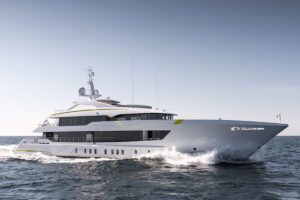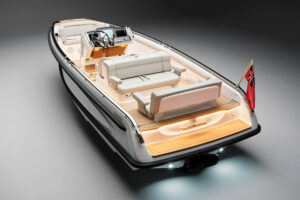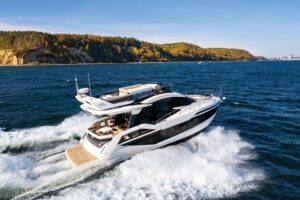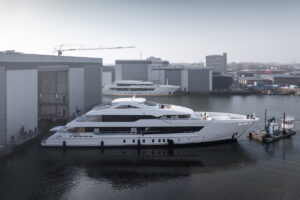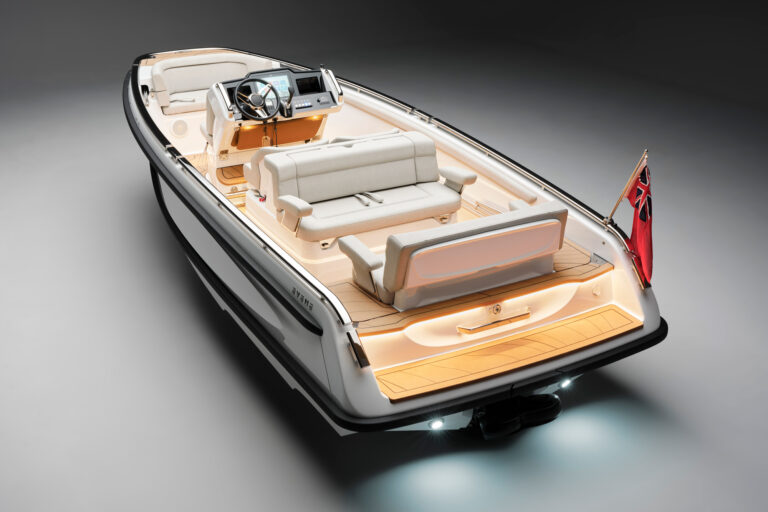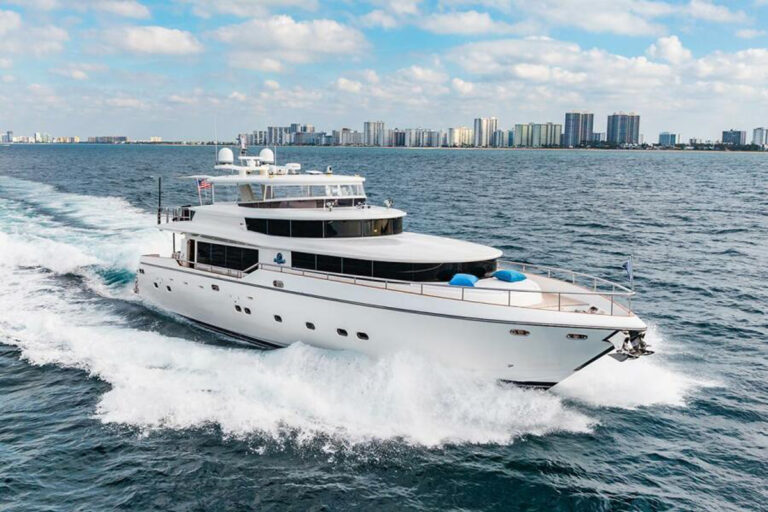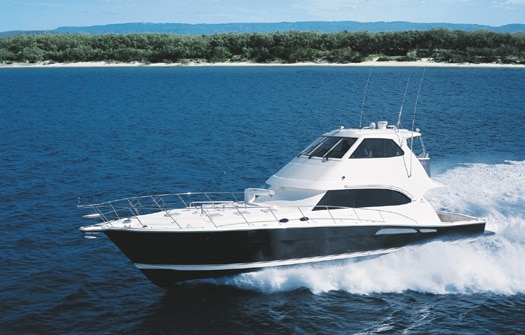
Naval architecture by Frand Mulder promises fine handling.
These days foreign boating brands have become commonplace on U.S. waters, thanks to the robust American market that has provided fertile ground for this globalization. But there is one niche that has always proven hard for outsiders to crack: convertible sportfishers. While these are as American as apple pie, Riviera Yachts of Australia seems to have found a winning recipe. Its latest offering, the 60 Flybridge, is bound to please American taste buds.
Australians have been so successful building sportfishers because they know a lot about sportfishing. You see, Australian waters regularly produce black marlin weighing more than a compact car. To pursue these large fish, Australians have been building the right boats for decades. Riviera was launched in 1980 and with just five employees built eight 38-foot boats in 12 months. By 1983, the young company had exported its first boat to the United States. Today Riviera employs 1,200 at its Coomera, Queensland, production facility and claims title as the “largest luxury boatbuilding complex in the Southern Hemisphere.” The U.S. market now accounts for approximately 40 percent of Riviera’s production-a fact not lost on the management team. Based on the American trend of “bigger is better,” Riviera now sends us the 60-the company’s largest-ever convertible. And she’s a beauty.
From the dock, the 60 looks every bit the part. Her profile is a tasteful blend of old and new, and fans of the marque will notice that she fits neatly in the evolution of the line. I would be remiss if I did not point out that this evolution, at least in my opinion, closely mimics several homegrown (U.S.) brands. However, with that said, the 60’s look is distinctive, and she is not just pleasing to the eye-she is a terrific-looking boat. This is quite an achievement considering that enclosed-bridge boats her size can often look a bit top-heavy. The gentle slope of her sheer and the cut of her stem are actually somewhat conservative, which should please tournament types who take tradition seriously. Her swim platform will likely appeal to those more interested in cruising. Proportionally, the elements of her design that are non-negotiable in terms of fishing are perfect. Add riggers and a tower and you’re ready for the tournament circuit.
Her cockpit has more than enough room for a full-size fighting chair, and a foundation is provided. In-sole fish/storage boxes can be fitted with removable liners and plumbed with macerator pump-outs. A transom livewell is standard. All cockpit sole hatches are guttered and can be securely latched. The bait-prep area has a refrigerated cool-box and a sink, and there is tackle storage in the molded cabinetwork and the bulkhead. An electric barbecue can also be fitted. Both fresh and saltwater wash-down taps are provided, and Glendinning cable systems (2x 50 amp) are standard. Fishermen will want to add the optional rod holders and padding for the coaming. The nonskid fiberglass cockpit finish is practical, but the teak cockpit sole is a nice touch if you have a mate to care for it. The optional cockpit controls seem like overkill to me unless you run short-handed, as there is a control station on the balcony as well as a spotter seat.
Step inside from the balcony and the helm-forward, air-conditioned enclosed bridge offers a comfortable perch protected from the elements. The captain won’t be lonely, for there is a large settee and wet bar with refrigerator. The helm is one area where Riviera’s designers seem to have liberated themselves from convention. With her sweeping, wrap-around form, she seems more sport boat than fish boat, but call me old-fashioned. There is plenty of room for electronics and you get firm grip on reality seated at the helm. The power steering is a plus, and the 60 responded instantly, executing hard turns predictably. Our test boat was fitted with the optional 10-cylinder, 1,520 hp MTUs, with which I recorded a maximum speed of 36.9 knots. With the throttles set at 2100 rpm, the 60 sped through the light chop at 32 knots as the engine electronics indicated a fuel burn of 110 gallons per hour. While sea conditions were mild, I have faith that her hull design by Dutch naval architect Frank Mulder will deliver the goods.
The 60 is built of hand-laid fiberglass in conventional female tooling. Her keel, chine and bottom are solid fiberglass; a fiberglass stringer system is supported by resin-coated marine plywood bulkheads and web-frames. The lamination schedule includes a skin coat of vinylester resin, and a white gelcoat finish is standard. Imron colors are offered as an option. As I have come to expect from Riviera, the 60’s excellent exterior finish reflects the investment the builder makes in its tooling. I found the same attention to detail in out-of-the-way places. Bilges on the 60 are finished with gelcoat and the lamination work appears neat and tidy.
The 60’s machinery space is accessible from the cockpit, with plenty of room to move about on centerline as well as access outboard of the engines. I was pleased to find machinery removal hatches in the saloon sole and internal sea-water strainers, features a number of American builders in this market have unfortunately abandoned. I also consider the fiberglass fuel tankage a significant plus along with the water-lift style mufflers and underwater exhaust. The latter is a standard feature on Riviera’s products-clearly they have sorted out the design. Standard generators are a 27.5kW and a 9kW Onans. Mechanical systems appear neat and tidy, and the level of finish in the engineroom is on par with production boatbuilding standards here in the U.S. Perhaps most important, Rivera’s standard within its own product line seems consistent. This is an important indication that the team at Riviera has a handle on quality control.
This is not to say that Riviera has not improved its products over the years. Those familiar with the brand will notice the subtle upgrades that savvy customers in the convertible market demand. Her interior, for example, is offered in teak (standard) or cherry. The cabinetwork is built by Riviera’s craftsmen, and the high-gloss teak finish aboard our test boat was impressive. Standard interior packages feature quality soft-goods and hardware, and owners can opt for a leather upgrade. Custom interior design services are also offered in-house. The 60’s saloon arrangement is fairly typical for a boat in her class. An L-shaped seating area aft faces a varnished teak cocktail table. There is a wet bar with a refrigerator and glass and bottle storage. A 32-inch flat-panel TV on a lift hides in the cabinetwork and presents itself with a push of a button. An open galley and a dinette area are forward. Standard features include two drawer-style refrigerators and a drawer-style freezer, a cook-top, microwave/convection oven, a dishwasher and a trash compactor. The four-stateroom arrangement has a master with a private head just forward of amidships, a VIP with an island berth and private head forward, and two smaller staterooms that share a head. It’s an excellent layout, but a three-stateroom option would be nice.
Our test boat fitted with the optional MTUs and electronics weighed in at $2,037,863. This includes a strong standard equipment list with everything from tableware to entertainment systems. Options worth considering include a watermaker and an additional freezer. The level of fishing equipment you require depends on how serious you are about catching fish. The 60 is up to the challenge and if you are committed to fishing or cruising, Riviera seems committed to building you a boat. In addition to a network of 21 sales locations in the Americas and the Caribbean, Riviera has corporate offices in South Florida. In my view this sort of investment is a key factor in considering a relationship with any foreign builder. Given this measure and the 60’s competitive position in terms of quality and pricing she seems an excellent value. n
Contact: Riviera Yachts, (561) 472-8800; www.rivierayachtsinc.com

